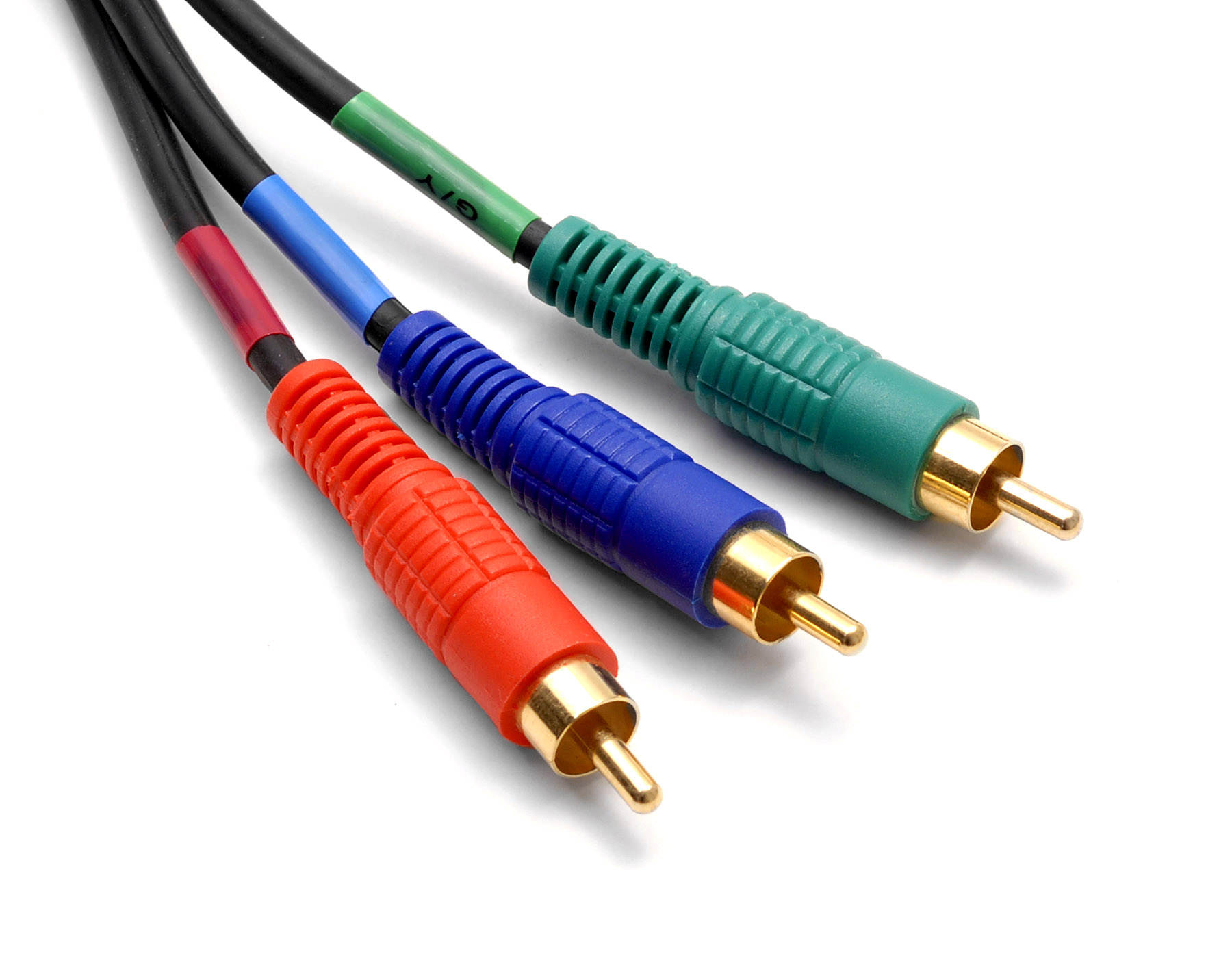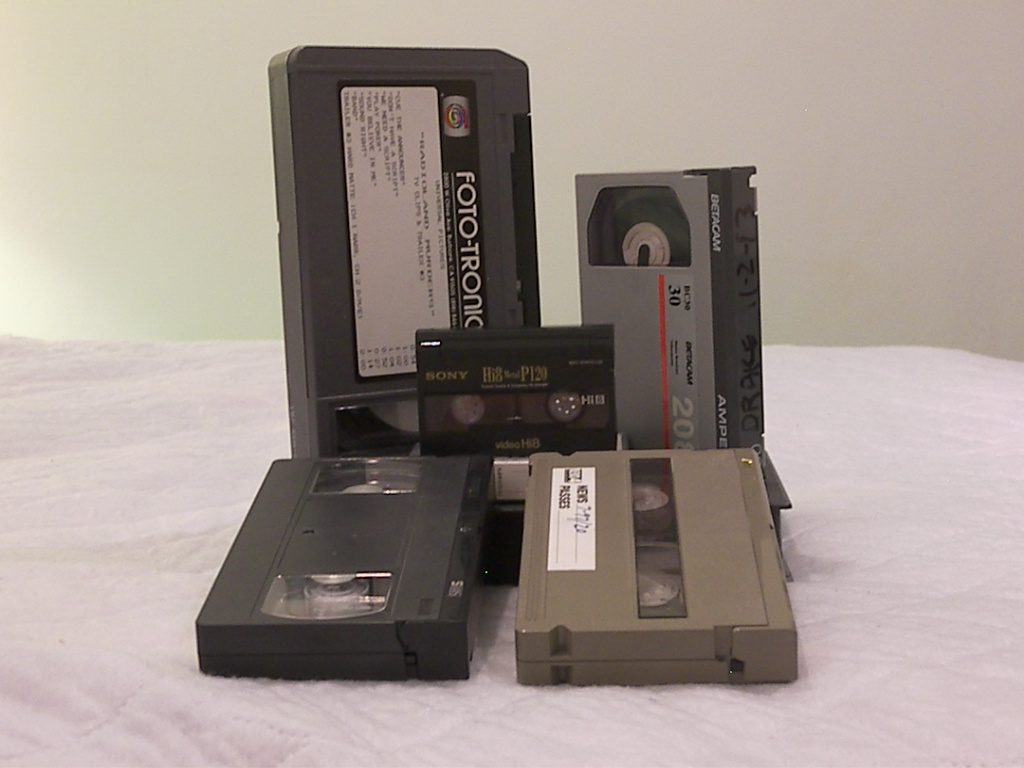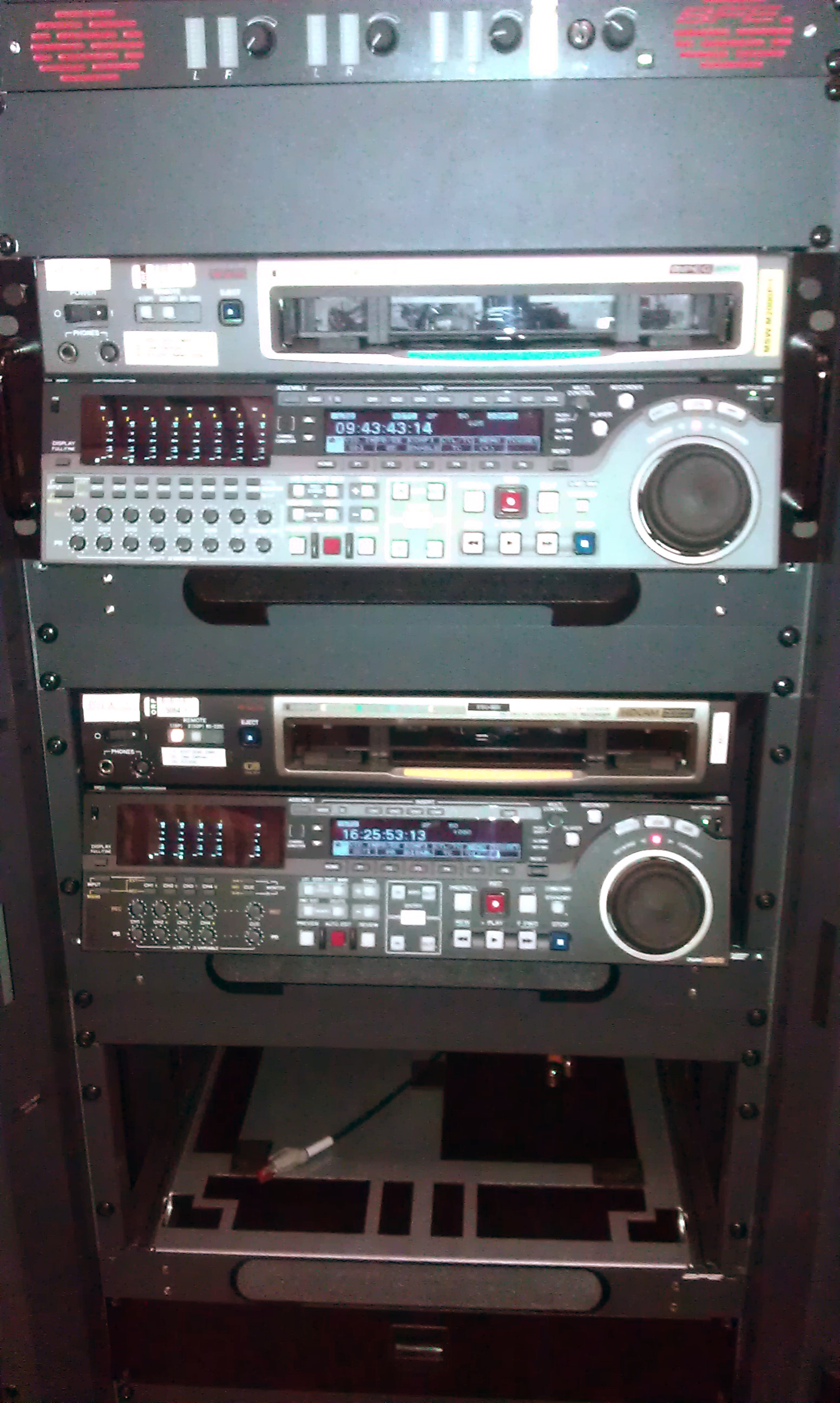|
M (videocassette Format)
M is the name of a professional analog videocassette format created around 1982 by Matsushita and RCA. Developed as a competitor to Sony's Betacam format, M used the same videocassette (and the same oxide-formulated magnetic tape stock) as VHS, much the same way that Betacam was designed to take advantage of cheap and readily available Betamax videocassettes, Overview The format was called "M" due to the shape of the threading path of the tape around the helical scan video head drum, which resembles a letter M. (This is also how the U-matic format got its name, for its U-shaped tape path in the VCR.) The M-shaped tape path was retained from VHS. An example M VCR is the Panasonic AU-300B, also sold as the Ampex ARC-40, and the M format was also sold by Ampex as the ARC format. Like Betacam, M recorded component video and used a much faster linear tape speed. A cassette that would yield 120 minutes on a VHS VCR at SP speed would only yield 20 minutes on an M VCR. M had ... [...More Info...] [...Related Items...] OR: [Wikipedia] [Google] [Baidu] |
Magnetic Tape
Magnetic tape is a medium for magnetic storage made of a thin, magnetizable coating on a long, narrow strip of plastic film. It was developed in Germany in 1928, based on the earlier magnetic wire recording from Denmark. Devices that use magnetic tape can with relative ease record and play back audio, visual, and binary computer data. Magnetic tape revolutionized sound recording and reproduction and broadcasting. It allowed radio, which had always been broadcast live, to be recorded for later or repeated airing. Since the early 1950s, magnetic tape has been used with computers to store large quantities of data and is still used for backup purposes. Magnetic tape begins to degrade after 10–20 years and therefore is not an ideal medium for long-term archival storage. The exception is data tape formats like Linear Tape-Open, LTO which are specifically designed for long-term archiving. Information in magnetic tapes is often recorded in tracks which are narrow and long areas of in ... [...More Info...] [...Related Items...] OR: [Wikipedia] [Google] [Baidu] |
Helical Scan
Helical scan is a method of recording high-frequency signals on magnetic tape, used in open-reel video tape recorders, video cassette recorders, digital audio tape recorders, and some computer tape drives. With this technique, magnetic tape heads (or head chips) are placed on a rotating head drum, which moves the chips at high speed by due to its high angular velocity. The speed of the head chips must be higher than the linear speed of the tape. The tape is wrapped tightly around the drum. The drum and/or the tape is tilted at an angle that allows the head chips to read the tape diagonally. The linear speed of the tape is slower than the speed of the head chips, allowing high frequency signals to be read or recorded, such as video. As the tape moves linearly or length-wise, the head chips move across the width of the tape in a diagonal path. Due to geometry, this allows for high head chip speeds, known as writing speeds, to be achieved in spite of the low linear speed of the tap ... [...More Info...] [...Related Items...] OR: [Wikipedia] [Google] [Baidu] |
MII (videocassette Format)
MII is a professional analog recording videocassette format developed by Panasonic in 1986 in competition with Sony's Betacam SP format. It was technically similar to Betacam SP, using metal-formulated tape loaded in the cassette, and utilizing component video recording. MII is sometimes incorrectly referred to as M2; the official name uses Roman numerals, and is pronounced "em two". Just as Betacam SP was an improved version of its predecessor Betacam (originally derived from Betamax) with higher video and audio quality, MII was an enhanced development of its predecessor, the failed M format (originally derived from VHS). There were two sizes of MII tape, the larger of which is close to VHS size and has a running time of up to around 90 minutes, the smaller tape was about half the size and runs up to around 20 minutes, and was also the size in which head cleaner tapes were supplied. Panasonic manufactured mains-powered MII editing and playback decks which accepted both ... [...More Info...] [...Related Items...] OR: [Wikipedia] [Google] [Baidu] |
Video Production
Video production is the process of producing video content. It is the equivalent of filmmaking, but with video recorded either as analog signals on videotape, digitally in video tape or as computer files stored on optical discs, hard drives, SSDs, magnetic tape or memory cards instead of film stock. Television broadcast Two styles of producing video are ''ENG'' (Electronic news gathering) and ''EFP'' (Electronic field production). Video production for distance education Video production for distance education is the process of capturing, editing, and presenting educational material specifically for use in on-line education. Teachers integrate best practice teaching techniques to create scripts, organize content, capture video footage, edit footage using computer based video editing software to deliver final educational material over the Internet. It differs from other types of video production in at least three ways:Moore, M. G., & Kearsley, M. G. (2012). 'Distance education: ... [...More Info...] [...Related Items...] OR: [Wikipedia] [Google] [Baidu] |
Frequency Modulation
Frequency modulation (FM) is a signal modulation technique used in electronic communication, originally for transmitting messages with a radio wave. In frequency modulation a carrier wave is varied in its instantaneous frequency in proportion to a property, primarily the instantaneous amplitude, of a message signal, such as an audio signal. The technology is used in telecommunications, radio broadcasting, signal processing, and Run-length limited#FM: .280.2C1.29 RLL, computing. In Analog signal, analog frequency modulation, such as radio broadcasting of voice and music, the instantaneous frequency deviation, i.e. the difference between the frequency of the carrier and its center frequency, has a functional relation to the modulating signal amplitude. Digital data can be encoded and transmitted with a type of frequency modulation known as frequency-shift keying (FSK), in which the instantaneous frequency of the carrier is shifted among a set of frequencies. The frequencies m ... [...More Info...] [...Related Items...] OR: [Wikipedia] [Google] [Baidu] |
Chrominance
Chrominance (''chroma'' or ''C'' for short) is the signal used in video systems to convey the color information of the picture (see YUV color model), separately from the accompanying Luma (video), luma signal (or Y' for short). Chrominance is usually represented as two color-difference components: U = B-Y, B′ − Y′ (blue − luma) and V = R-Y, R′ − Y′ (red − luma). Each of these different components may have scale factors and offsets applied to it, as specified by the applicable video standard. In composite video signals, the U and V signals modulate a color subcarrier signal, and the result is referred to as the chrominance signal; the Phase (waves), phase and amplitude of this modulated chrominance signal correspond approximately to the hue and Saturation (color theory), saturation of the color. In digital-video and still-image color spaces such as Y′CbCr, the luma and chrominance components are digita ... [...More Info...] [...Related Items...] OR: [Wikipedia] [Google] [Baidu] |
Component Video
Component video is an analog video signal that has been split into two or more component channels. In popular use, it refers to a type of component analog video (CAV) information that is transmitted or stored as three separate signals. Component video can be contrasted with '' composite video'' in which all the video information is combined into a single signal that is used in analog television. Like composite, component cables do not carry audio and are often paired with audio cables. When used without any other qualifications, the term ''component video'' usually refers to analog component video with sync on luma (Y) found on analog high-definition televisions and associated equipment from the 1990s through the 2000s when they were largely replaced with HDMI and other all-digital standards. Component video cables and their RCA jack connectors on equipment are normally color-coded red, green and blue, although the signal is not in RGB. YPbPr component video can be los ... [...More Info...] [...Related Items...] OR: [Wikipedia] [Google] [Baidu] |
Ampex
Ampex Data Systems Corporation is an American electronics company founded in 1944 by Alexander M. Poniatoff as a spin-off of Dalmo-Victor. The name ''AMPEX'' is an acronym, created by its founder, which stands for Alexander M. Poniatoff Excellence.AbramsoThe History of television, 1942 to 2000– McFarland, 2003 – , page 286, Chapter 2, footnote 34 "1944 he founded Ampex (the name was created from his initials, AMP, plus "ex" for excellence)" Ampex operates as Ampex Data Systems Corporation, a subsidiary of Delta Information Systems, and consists of two business units. The Silicon Valley unit, known internally as Ampex Data Systems (ADS), manufactures digital data storage systems capable of functioning in harsh environments. The Colorado Springs, Colorado, unit, referred to as Ampex Intelligent Systems (AIS), serves as a laboratory and hub for the company's line of industrial control systems, cyber security products and services and its artificial intelligence/machine learnin ... [...More Info...] [...Related Items...] OR: [Wikipedia] [Google] [Baidu] |
U-matic
U-matic, also known as -inch Type E Helical Scan or SMPTE E, is an analog recording videocassette format developed by Sony. First shown as a prototype in October 1969 and introduced commercially in September 1971, it was among the earliest video formats to house videotape inside a cassette, replacing the reel-to-reel systems common at the time. The format uses tape, earning it the nickname "three-quarter-inch" or simply "three-quarter," in contrast to larger open-reel formats like Type C videotape and quadruplex videotape. The name ''U-matic'' refers to the U-shaped tape path as it threads around the video drum. Unlike most cassette formats, U-matic's supply and take-up reels rotate in opposite directions during playback, fast-forward, and rewind—one clockwise, the other counterclockwise. Each cassette has an internal locking mechanism that secures the tape hubs during transport, and a spring-loaded door that protects the tape; this door automatically opens when the casse ... [...More Info...] [...Related Items...] OR: [Wikipedia] [Google] [Baidu] |
Magnetic Tape
Magnetic tape is a medium for magnetic storage made of a thin, magnetizable coating on a long, narrow strip of plastic film. It was developed in Germany in 1928, based on the earlier magnetic wire recording from Denmark. Devices that use magnetic tape can with relative ease record and play back audio, visual, and binary computer data. Magnetic tape revolutionized sound recording and reproduction and broadcasting. It allowed radio, which had always been broadcast live, to be recorded for later or repeated airing. Since the early 1950s, magnetic tape has been used with computers to store large quantities of data and is still used for backup purposes. Magnetic tape begins to degrade after 10–20 years and therefore is not an ideal medium for long-term archival storage. The exception is data tape formats like Linear Tape-Open, LTO which are specifically designed for long-term archiving. Information in magnetic tapes is often recorded in tracks which are narrow and long areas of in ... [...More Info...] [...Related Items...] OR: [Wikipedia] [Google] [Baidu] |
NTSC
NTSC (from National Television System Committee) is the first American standard for analog television, published and adopted in 1941. In 1961, it was assigned the designation System M. It is also known as EIA standard 170. In 1953, a second NTSC standard was adopted, which allowed for color television broadcast compatible with the existing stock of black-and-white receivers. It is one of three major color formats for analog television, the others being PAL and SECAM. ''NTSC color'' is usually associated with the System M; this combination is sometimes called NTSC II. The only other broadcast television system to use NTSC color was the System J. Brazil used System M with PAL color. Vietnam, Cambodia and Laos used System M with SECAM color – Vietnam later started using PAL in the early 1990s. The NTSC/System M standard was used in most of the Americas (except Argentina, Brazil, Paraguay, and Uruguay), Myanmar, South Korea, Taiwan, Philippines, Japan, and some Pacific Isl ... [...More Info...] [...Related Items...] OR: [Wikipedia] [Google] [Baidu] |
Betacam
Betacam is a family of half-inch professional videocassette products developed by Sony in 1982. In colloquial use, ''Betacam'' singly is often used to refer to a Betacam camcorder, a Betacam tape, a Betacam video recorder or the format itself. All Betacam variants from analog Betacam, Betacam SP and Digital Betacam, HDCAM and HDCAM SR use the same shape videocassettes, meaning vaults and other storage facilities do not have to be changed when upgrading to a new format. The cassette shell and case for each Betacam cassette is colored differently depending on the format, allowing for easy visual identification. There is also a mechanical key that allows a video tape recorder to identify which format has been inserted. The cassettes are available in two sizes: S (short or small) and L (long or large). The Betacam camcorder can only load S magnetic tapes, while television studio sized video tape recorders (VTR) designed for video editing can play both S and L tapes. The format s ... [...More Info...] [...Related Items...] OR: [Wikipedia] [Google] [Baidu] |










